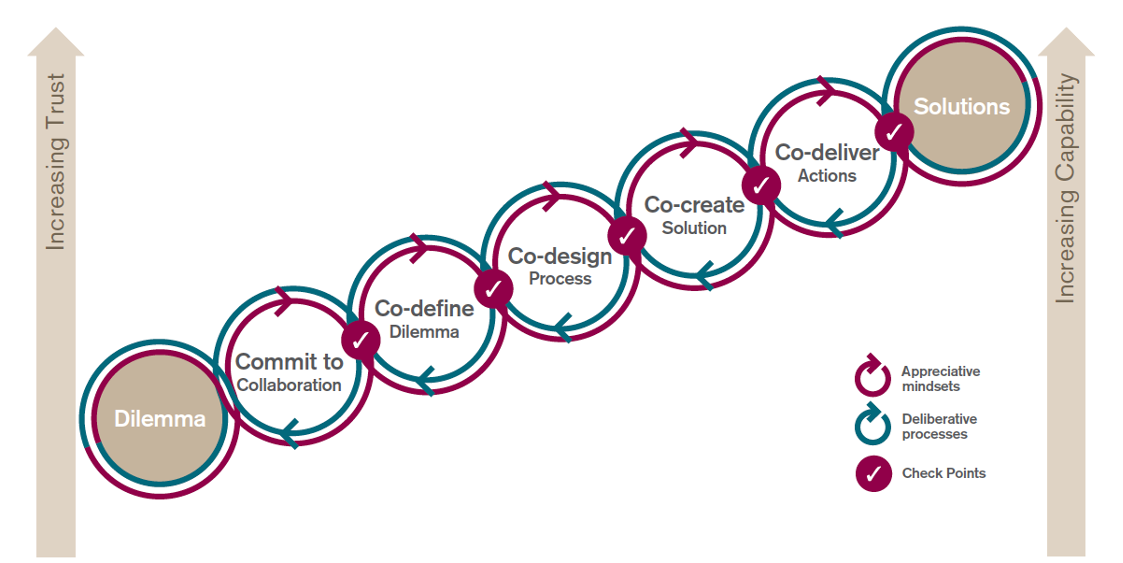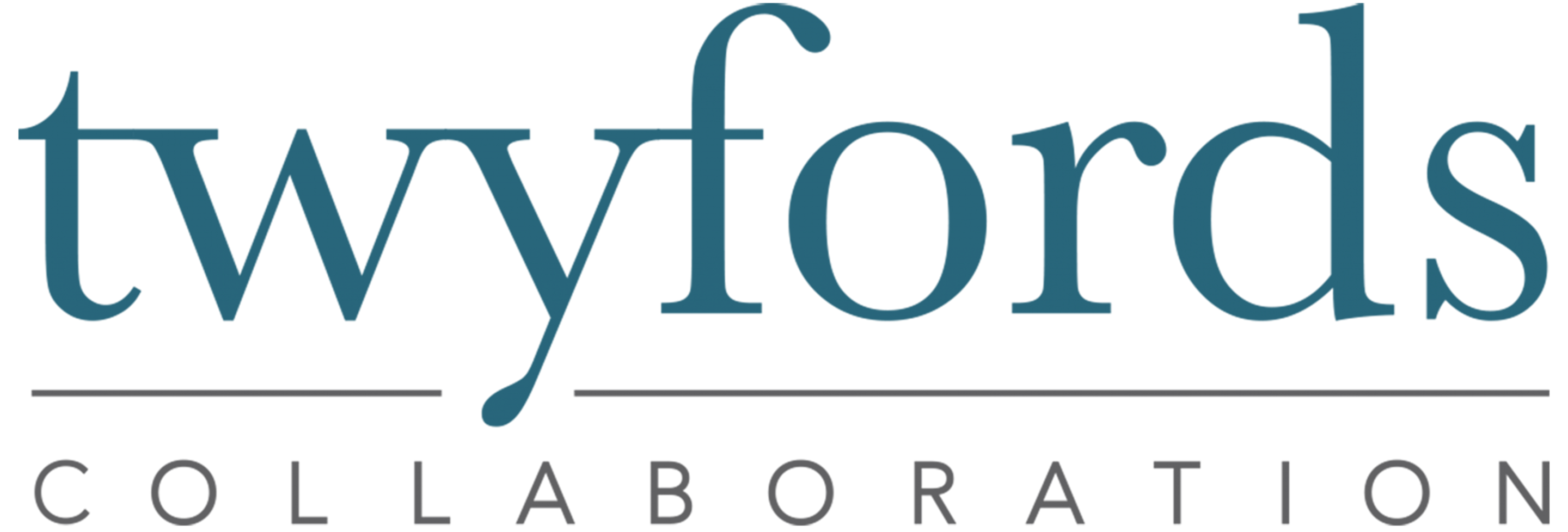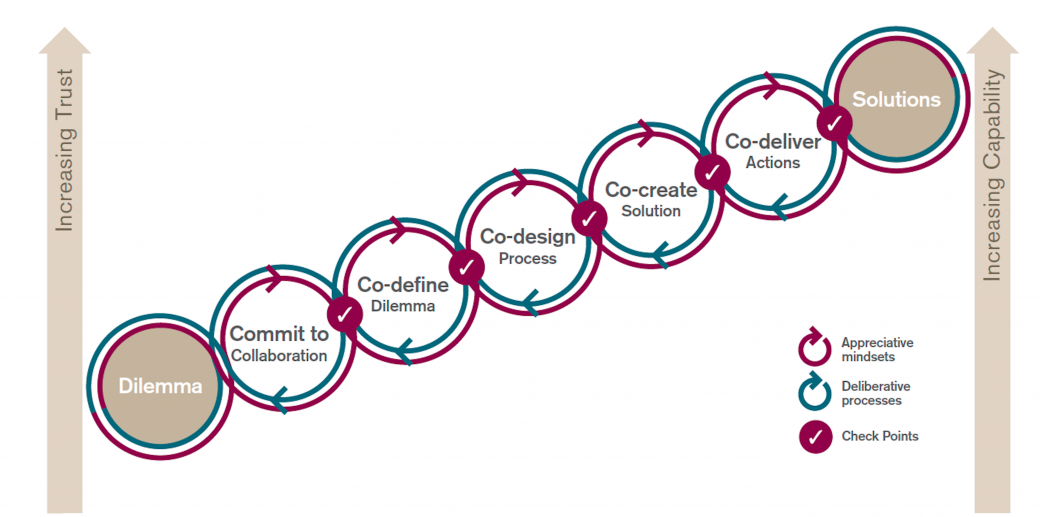Are there Five Steps to Collaboration?
If you have read our or worked with us over the past 10 years you will know that we talk about our five-step pathway for collaboration. We call it the Power of Co Pathway. We built it as a step-by-step guide to help collaborators know what to do and when to do it. The five steps are:
- Commit to collaboration
- Co-define the dilemmas
- Co-design the process
- Co-create solutions
- Co-deliver actions.
 The framework is simple, clear and the evidence suggests that it works well.
The framework is simple, clear and the evidence suggests that it works well.
Yet over the years we have come to realise that collaboration can never be fully described by a linear, step-by-step model. Collaboration tends to be organic, emergent and fluid rather than neat and linear. In our collaborative work we saw that the stages blend and merge, run in parallel and interact with each other in a creative and wonderful way. Often, people begin half way along, perhaps at Co-create, then find themselves going back to Co-defining the dilemma together when the realise they need to better understand what’s going on. All of which builds their Commitment to Collaboration, which in turn allows them to do work on Co-designing the process together so that they can get back to finding solutions.
Productive? Yes. Linear? No.
Which inspired us to rethink the structure of our pathway. The steps are the same but we have begun to represent them more as a system. Importantly, commitment to collaboration is at the heart of the journey because everything we do should be about building and growing the momentum and energy for working together. The other four are represented in a clockwise sequence, but in reality we can move from any step to any other, through the commitment circle in the middle.
 So when you are collaborating you can start anywhere, go everywhere on the Power of Co Pathway. Think of it less as five steps to follow and more as five precious ideas to carry with you on your journey. Any and all of them can be useful and relevant wherever you are.
So when you are collaborating you can start anywhere, go everywhere on the Power of Co Pathway. Think of it less as five steps to follow and more as five precious ideas to carry with you on your journey. Any and all of them can be useful and relevant wherever you are.
Which of the ideas do you need to tap into today in your work?
Explore More
Our Collaborative Pathway is the topic of discussion in our next free webinar. to learn more about the linear versus emergent aspects of working with others.
The Heart of Collaboration
There is a lot of energy expended bringing people together to find solutions to complex problems, but getting diverse stakeholders in the room together is no guarantee of success. Why do some efforts to co-create solutions founder when others succeed? It often comes down to three important steps of collaborative work that can be overlooked or underdone, yet together these three steps form the heart of any authentic collaboration.
Where trust is low and scepticism is high, what is it that allows people to work together to find solutions? An absolutely critical piece in the puzzle is that everyone trusts the process. Many clients seek to address this issue by hiring an “independent facilitator” to manage the co-creation process. “You may not trust us but you will trust this person we are paying, right?” Wrong! “If I don’t trust you why would I trust your hired gun? And even if they are fabulous, why would I trust that you will listen to us or respect our views in this?”
Co-design
In order that all stakeholders trust the process we have learned how important it is that they get their fingerprints on it. In others words, we want them – and all of us in the collaboration – to own the process by which we will work together to co-create solutions. Successful collaborators design the conversation together, the data, the questions they will ask, agreeing the boundaries, identifying the stakeholders together. They discuss and own the decision-making process, the criteria, the options development etc. And all this great collaboration happens before they start to talk about solutions. So that when they get to that step in the process they are ready, committed, engaged and able to truly co-create together. Even if trust in the ‘who’ remains low, trust in the ‘how’ allows progress to be made.
Co-define
But where trust is low and the project, problem or situation is seen very differently by different stakeholders, invitations to help co-design the conversation are likely to be met with stony silence. “Why would I talk to you about collaborating when I believe that you are the problem?” What is it that makes the co-design step flourish? In our experience collaborators are much more likely to step into the process when they feel that the problem or project that brings them together is something they are a part of, they understand and feel is worth their precious time. Building a shared sense of the complex situation we face together and taking ownership for our own piece of that bigger problem is the magic of Co-defining. Only when we have all heard each other on the nature of the problem and found some agreement on aspects of it, can we productively move into co-designing and co-creating.
Commit to collaboration
So we come to the root question. What makes stepping in possible for those who don’t trust the system and don’t see the problem, or feel they already know what the solution is? This is the commitment question. It is both a pre-cursor to co-defining and co-designing and an integral part of each. It is about my/our commitment to collaborate with ‘them’ and ‘their’ commitment to working with us on this.
If we skip over the first three steps – Commitment, Co-definition and Co-design – and begin with Co-creating, how can we expect a high level of commitment? And in the absence of commitment, how can we do the difficult work together to find solutions to our complex problem?
There is a pathway to follow when collaborating and it begins well before we attempt to find solutions. In your work are you collaborating from the heart?
You can find more about the whole collaborative pathway on our website under
Collaboration- Assert and Love?
A client recently talked about the seeming ‘bi-polar’ nature of their organisation, where they see a strong desire for good relationships with their stakeholders, which can feel at odds with their role as a regulator and being strict on the rules, even when this damages relationships.
It reminded me of Adam Kahane’s book we discussed in our February blogs (“Collaborating with the Enemy”- Berret-Koehler, 2018)
As well as his simple framework around collaboration as a choice, Adam also suggests that being able to move between “asserting” (having the power), and “love” (building relationships) is actually a key if one chooses the multilateral approach.
This parallels our experience, where we often see people vacillating between wanting to drive in a particular direction, and waiting to build consensus together. They can be nervous about which path is “right”, rather than acknowledging that both might be appropriate and part of effective collaboration.
So when is "assert" and when is "love" appropriate? According to Kahane, asserting reflects the need for individuality, the importance of respecting that individual’s difference and their piece of the truth, and their need for control.
Love on the other hand respects the collective, and the fact that only by being together can we find the collective truth. It recognises that if the individual is not part of the collective problem, then they can’t be part of the collective solution.
If one seeks consensus too much, one might give up too much and let down their constituency.
If one asserts too much, one might damage the relationships and be unable to reach a required consensus.
So if we assume that “assert” and “love” need to exist in a symbiotic relationship for effective collaboration, what does that mean for the collaborator?
How do you manage that internal conflict?
Your Lonely Plant Guide to Collaboration
There we were, three young backpackers fresh off the train in Florence, Italy, with an intention to stay for a bit and see all this beautiful city had to offer. The only ‘plan’ we had was to stay in a place someone had told us about at our last accommodation – a grand old villa that apparently had something to do with Mussolini’s mistress. We had a bus route number so off we went to the bus stop. The 39C came along – just the one we wanted - and on we climbed.
45 minutes later in winter darkness, the bus was empty and we had no idea where we were, where we were going or where to get off. The industrial buildings outside looked very unpromising in the wan glow of the occasional streetlight. We were lost! There was only one thing to do – reach for our dogeared copy of the Lonely Planet Guide to Florence. We found the section on transport that explained how bus routes work, and realised what was going on. We were on the right bus, but the wrong ‘direction’ heading on 39C East instead of West. I don’t believe Mussolini’s mistress had ever been to this part of Florence.
The helpful driver confirmed our mistake and we sat on that bus for the next 90 minutes while we retraced our steps and then headed out to the other side of the City. Villa reached. Backpacks unloaded. Nervous, relieved laughter. Exhausted sleep.
I have designed, facilitated and lead enough collaborative processes to know that I sometimes feel lost. I’m not sure what to do next, where to go or how to get there. Where is my Lonely Planet guide to Collaboration when I need it?
Experiences such as these inspired us at Twyfords to look back over our collaborative journeys to find out what the key steps to success were. Could we extract a common approach to create a map to guide our future collaborations? Turns out we could. What emerged was a five-step pathway we now call the Power of Co Pathway. You can read more about it . The point is that collaboration has a map. There is a pathway to guide us on the sometimes difficult journey of working with diverse people, values and opinions. The collaborative pathway has been guiding us and our clients for years and along with a collaborative mindset and a collaborative skillset, forms our .
So whether you are lost in Florence or lost in your collaboration, turn to the guide that shows you the path forward.
Find out more about our Pathway and our Collaboration System on our .
Beware the Dark Side
In his recent blog post John wrote about a decision tree developed by Adam Kahane to help with that perennial question – “when should I collaborate and when not?” The framework gives us four options: leave, adapt, collaborate and force. This post is about the ‘force’ option.
In summary, Kahane’s framework gives us a way to determine our options. Where we can’t change a situation and can’t put up with it, our option is to leave. When we can put up with it our option is to do so, to adapt. If we can change a situation but only through working with others, we collaborate. Where we can change the situation unilaterally we force it.
In my experience clients often are freed up by the idea that there are times when they can just do it, act unilaterally and force it. I can understand their reaction, but want to point out the obvious dark side of the force. If this option becomes an excuse to maintain a command and control dynamic then this is risky territory for any leader.
Just like in the movies, the ‘Force’ can be used for good if done with the appropriate intention and mindset. If we define forcing quite broadly as describing those situations where I maintain decision-making rights, this allows me the decision-maker some room to work with others. I can seek feedback on my draft decision. I can get some ideas from them but then make the call myself. I can even sit with them and generate some new knowledge together. Or as I am making my decision I can simply explain to everyone where I’ve got to and why. In each case if I am applying the force option I will ultimately make a unilateral decision and everyone will have to put up with it. But because they have been on the journey to an extent, they are themselves likely to be more able to choose to live with it than leave.
So the force option is always there and when you have the power it is tempting to use it to its fullest extent. But beware the path that leads to the dark side. The smart leader knows that working with others always has value. With a collaborative mindset even the force option of unilateral decision-making can be a more inclusive one.
We all know we mustn’t underestimate the power of the dark side. My realisation is that we often underestimate the power of doing ‘with’ not ‘to’.
May the force of collaboration be with you.
If you would like to find out more about how to develop a collaborative mindset and skillset, why not get in touch today?
Are your collaborative contracts really collaborative?
A couple of years ago I worked with a major utility that wanted to change the nature of their services contracts.
Previously they had run a very top down, top heavy process requiring the contractors to jump through many process hoops, which left them feeling very constrained and powerless.
The provider started a new process stating they wanted it to be a more collaborative, flexible and outcome focused regime where contractors would be valued as equal partners.
What was interesting were the comments that I heard from the contractors during the subsequent implementation process, which were quite revealing about the attempted change.
I heard comments like:
- this doesn't feel very collaborative
- you are still the "big gorilla" in charge of the cash
- but you are just telling us how it will work
- I'm not sure you really trust me....
While the new contracts were reasonably well received, and seemed to provide benefits, it soon became apparent that these new arrangements were just a bit better, rather than the quantum shift that had been planned.
While it looked different to the utility, it felt the same to the contractors- in the contractor's mind, the real power and control continued to reside with the utility, so it seemed that nothing had really changed.
And maybe that gives us a clue as to what might make a difference- it takes a different mindset to make a process truly collaborative, which drives different thinking, behaviour and actions:
- thinking we, not me
- giving up control and not always knowing the answer
- paying attention to relationships, and building trust before presenting solutions
- allowing those involved to get their "fingerprints" on the process
So there is a big distinction between doing collaboration, and it feeling collaborative.
The mindset is the difference.
Three ways to take your contractual partnership from good to great
A client in the water infrastructure business recently approached me to talk about how the team can learn to work together with their contracted construction partners as they deliver a massive bit of infrastructure. They told me that the relationship between them and their delivery partner is good but that, in a competitive world where margins are slim, they would only deliver on budget if their partnership shifts "from good to great". They needed to shift their collaboration to a new level or risk their profit margin.
With the growth of alliance contracts and governments' preference for outsourcing service delivery to contractors, this is an increasingly common scenario. Yet while it is one thing to be a contractual partner, it is another thing altogether to develop the collaborative mindset and behaviours that make these contractual relationships hum. How does my client move from an 'us and them' mindset to a 'we' mindset, and do so in the high-pressure world of project delivery? It isn't easy, but here are three things I've learned:
- A partnering contract alone does not a partnership make. Behaviour and, most importantly, thinking has to shift in order to give the contractual aspiration a chance.
- A commitment to working on relationships and a process for doing so is critical. You can’t just focus on doing the content work better.
- To build collaborative muscles we need to go to the collaboration gym, so build in a way for practice, reflection and learning.
To support clients on their partnering and alliance journeys we have developed our unique and coaching process. We will be talking through key aspects of the approach in our . We hope to see you there so you can take your contractual partnerships from good to great.
Those silos are still around!
In thinking about this month’s topic on silo busting, I was reminded of my blog four years ago:
Following a successful workshop a couple of weeks ago on setting up a collaborative framework for a project with a bunch of internal staff, the manager said to me that she couldn't believe how well the group had worked together, and how "they got more done in 2 hours than we had done in the last 2 months!"
She was surprised, which struck me as a bit unusual until I realised how uncommon working well together must be in that organisation.
I reflected back on my 32 years in a big corporate in a past life and remembered the challenges I experienced in working with teams there- the constant battles between the organisational silos- engineering and production, HR and OD, marketing and sales- hoarding of information, and the strong positions and solution focus that each group took into each session. Then I realised that my recent client was experiencing that same culture of brick walls I had experienced for years.
I also realised that my experience of the last 12 years had been quite different, as I had got so used to a different pattern and so what we saw with the group was more the norm to me, but quite unusual for her.
While I was the facilitator in that case, it reminded me once again that it is not fundamentally the tools or skills I had that made the difference- it was the collaborative thinking that helped people work across their organisational boundaries - people getting to know each other better, willingness to share information, deeply listening to a diversity of views, and their willingness to take ownership of something that they felt important.
This resonated with me yesterday as I read a really interesting , where a government agency had focused on collaboration as a starting point to tackle the lack of innovation, in a traditional organisation.
In the case, the key agency Director acknowledges some of the challenges in changing the way the staff work given they felt overwhelmed, siloed, too busy, no info sharing, etc, and how "winning the hearts and minds" of the staff was key task for her collaboration facilitators.
So I'm now more mindful of the effect of the organisational "tribes" and the unconscious and mostly unintended influence they can have on getting good results together, and the power of collaboration in breaking up those silos.
So what have I learned in the meantime?
- The dynamics around silos haven’t gone away
- People are more aware of the issues around organisational barriers and how to respond with more useful collaborative behaviours:
- Listen more
- Pay attention to the relationships as well as the content
- Share information
- Check assumptions about each other
- We’ve found that a simple tool can be really powerful in seeing each other in a new light by revealing and challenging such assumptions. Try it out .
How are you finding those silos? A barrier - or an opportunity to learn and try new stuff?
The Joy of Silos
A quick search on the Net for ‘organisational silos’ generates an endless list of headlines such as:
- Breaking down silos for customer experience
- The silo mentality: how to break down the barriers
- Six strategies for breaking down silos
- How to fix workplace silos
- Reasons to permanently remove your organisational silos”
The list goes on.
At the same time, my clients say things like:
- “The two Divisions aren’t working together like I need them to. We have to get rid of these silos…”
- “The left hand never seems to know what the right hand is doing around here. There’s too many silos…”
- “The conflict seems to be growing between the groups because of our silo mentality”
- They can’t sort out the problems themselves so things get escalated to me and I don’t have time to deal with that. I need help to break down these silos”
No surprises here, perhaps apart from the fact that we are still saying these things after who knows how many decades of effort to ‘fix’ silos. I suspect that people would have had very similar complaints soon after the dawn of bureaucracy and the large organisation, yet we keep repeating ourselves and keep seeking the solution.
Worse, most of my clients seem to spend most of their working life under a mind-numbing state of restructuring, that tiresome quest for the Nirvanas where structure lives but silos don’t.
Isn’t it time to acknowledge that the quest to restructure away or otherwise kill our silos is akin to the hunt for the unicorn? It’s probably time to give it a rest.
So if we admit defeat and stop trying to restructure our silos to extinction, what’s Plan B? I say it is time to embrace our silos; time to stop trying to kill them; time to stop fruitlessly redesigning them; time to stop using them as an excuse. It is time to learn to work across them effectively and make those silos hum.
This means we:
- Cease the endless restructuring and work with what we’ve got.
- Stop blaming the ‘silos’ for getting in the way
- Stop blaming them – the other group – for being hard to work with or not ‘getting with the program’.
Instead, as organisations we:
- Focus on building our relational capability and the skills we need to work with other humans;
- Build our ability to work in complex situations, to think systemically across silos
- Strengthen our collaborative muscles, which are a key to success regardless of the organisational structure.
And as individuals we switch the frame:
- from competition across silos to collaboration
- from mistrust to extending trust
- from me to we
- from telling to asking and listening.
These things are hard to do – perhaps harder than calling in an expert to lead a restructure process – but might it be that the hard road is the one that offers a road to improvement?
Perhaps it is time to love our silos.
The terrifying journey to co-design
When I was in high school I remember travelling to a school sports carnival in the city, an hour away to the north. The sports teacher drove us to the event in the school's hard-working minivan.
I live in the Illawarra on the NSW south coast. Returning home from the north requires the driver to leave the highlands and head down the notorious escarpment to the coastal plain. It is a long, steep decline and, as I learned that day, a potentially terrifying drive. On that particular day I had the misfortune to be in the front passenger seat. Normally this would be fine, but it quickly became abundantly clear that our sports teacher was a frustrated racing car driver. He piloted that van like his life depended on it, diving off the mountain and plunging at buttock-clenching speed down the Pass. I had a front row view of each and every near miss, grazed guard rail and hair-raising hair-pin bend. When we commenced that trip home I was a confident teenager in the prime of life. By the time we made it home I was a gibbering wreck. And the teacher? He was cool as a cucumber, unaware of the terror he'd inspired in me and others.
There are two long-term lessons I've carried with me from this (mis)adventure. First - never, ever get back in a van with my high school sports teacher. And second, having no control is a really scary position to be in. The thing is, I've been driving myself now for decades, and I've long realised that I too am a frustrated racing car driver. I often charge down the mountain, enjoying every near miss, grazed guard rail and hair-raising hair-pin. And at the bottom of the hill I'm not a gibbering wreck but a cool cucumber. As for my passengers? I'm not sure really. It isn't easy to talk to someone who seems to be curled up in a foetal position with the seatbelt clenched between their teeth and eyes out on stalks.
The difference is that as the driver I am in control. I have my hands on the wheel and I trust myself to get to the bottom of the hill safely. But as that schoolboy front seat passenger, I was along for the ride but my hands weren't on the wheel (they were mostly over my eyes as I recall). It was someone else's journey and I felt totally out of control. Not a nice feeling.
I've realised that this very same dynamic applies to problem-solving processes. If someone else is expecting me to participate in a process exclusively designed and run by them it can feel like plunging over the escarpment with a deranged teacher at the wheel. But when I am invited into co-designing the process I can feel more confident about how this is going to end. Getting my fingerprints on the process is like being at the wheel. If you want my buy-in then you'd better find a way to allow me some control not only of where we are going but how we plan to get there together. That is, don't just invite me in to work on the problem with you. Invite me in to help design how we are going to work on the problem together.
Our has a strong element of built into it for just this reason. Co-designing process is an integral part of the collaborative journey. So my advice is to let your collaborators share the driving. The more control they have over 'their' process, the more commitment, energy and innovation they will bring to the task of solving problems together. With co-design you will be able to conquer any mountain together.










